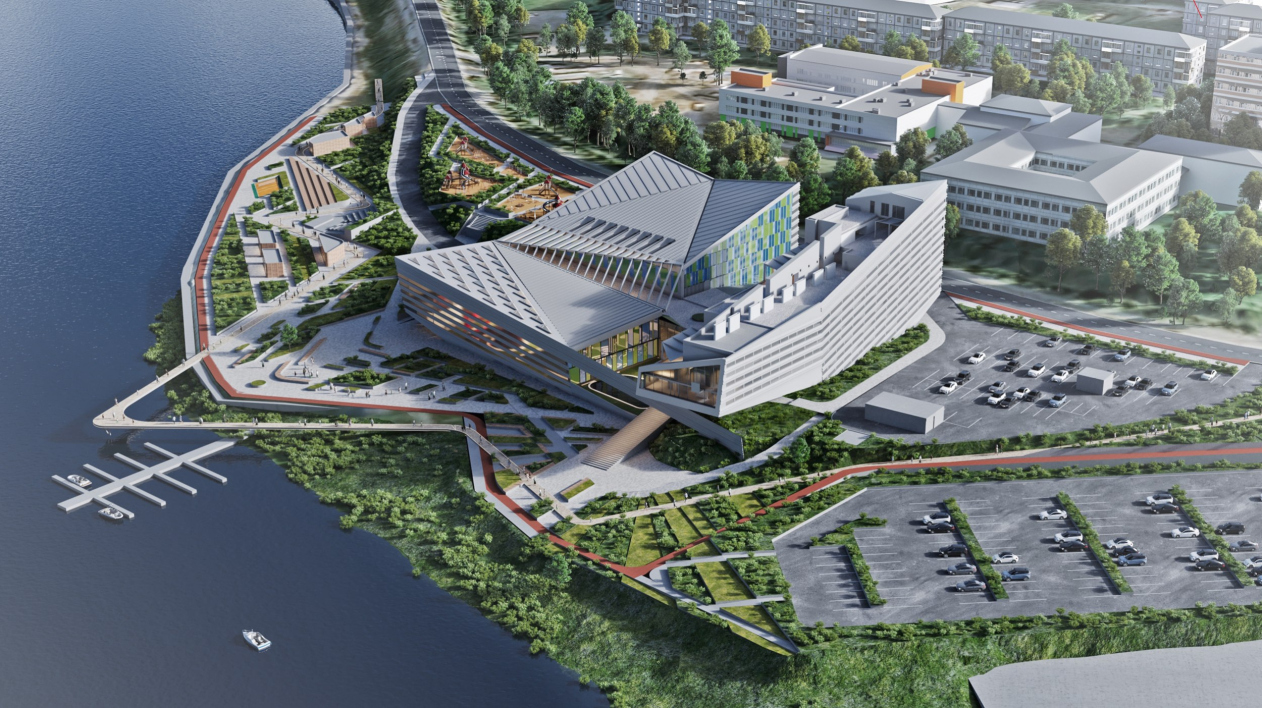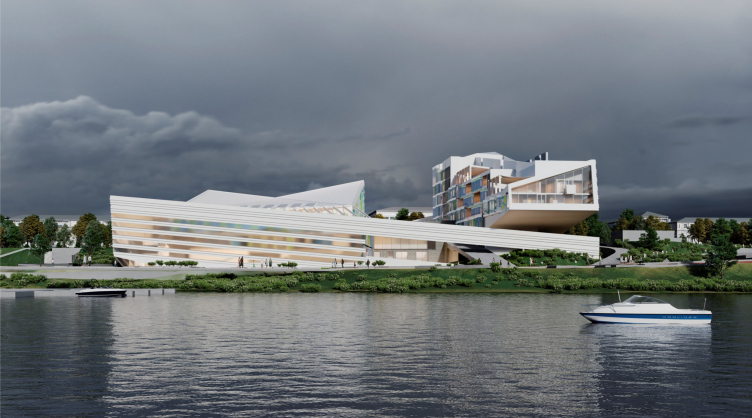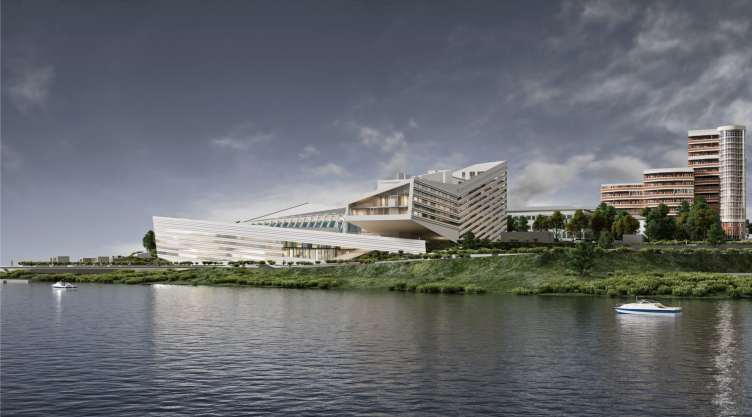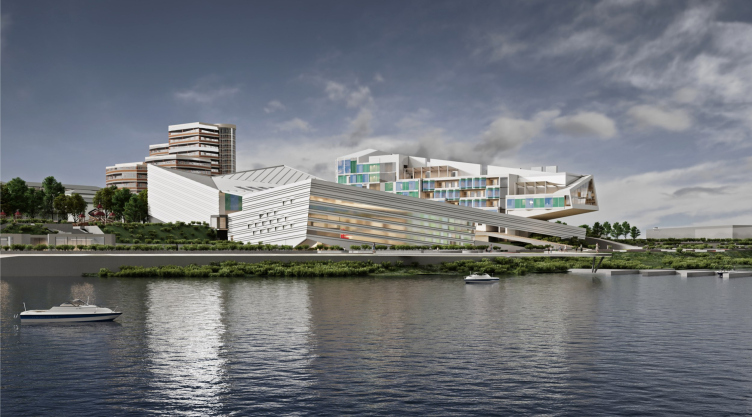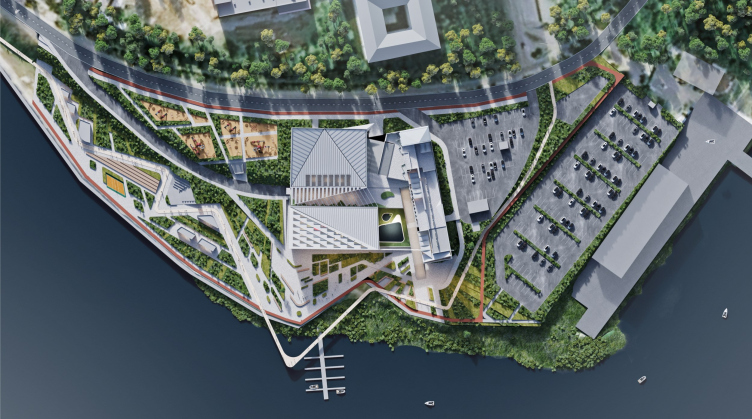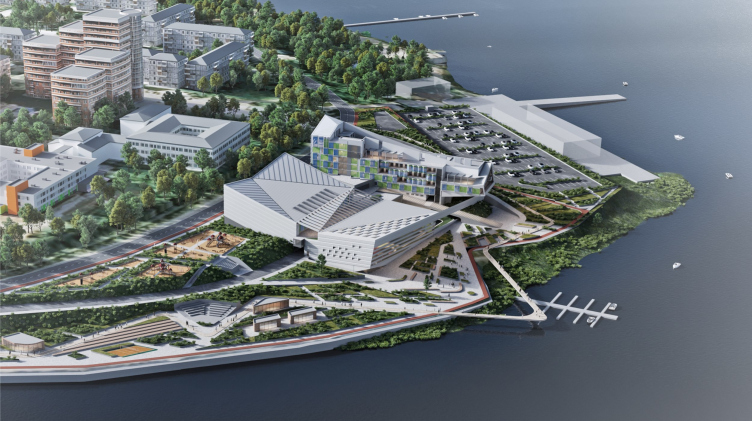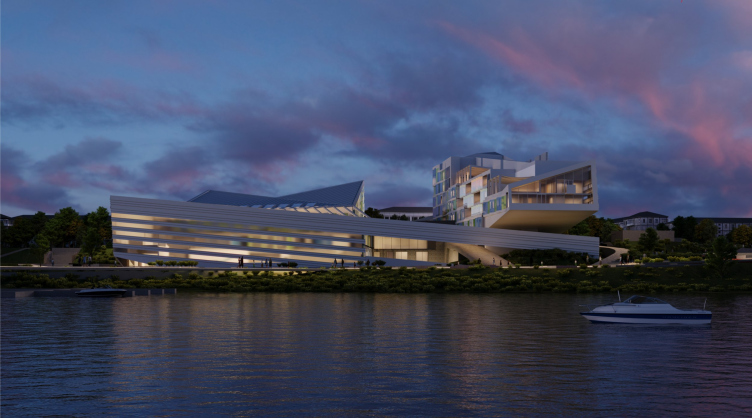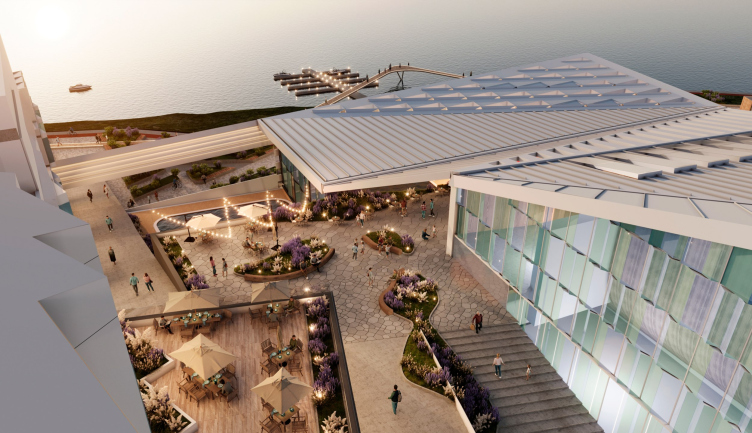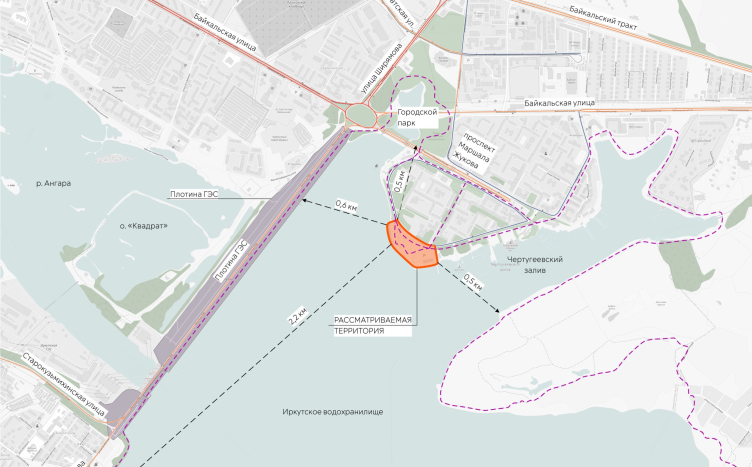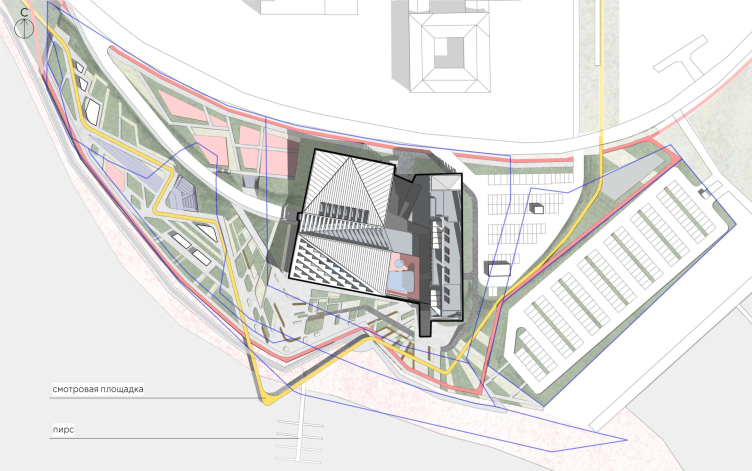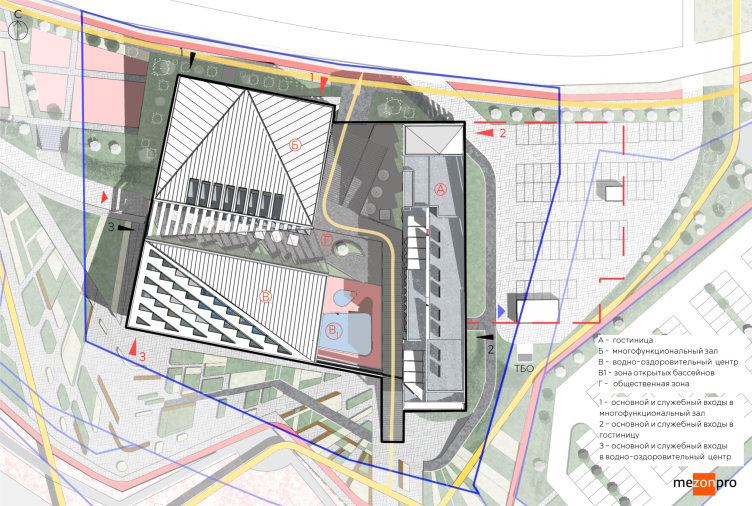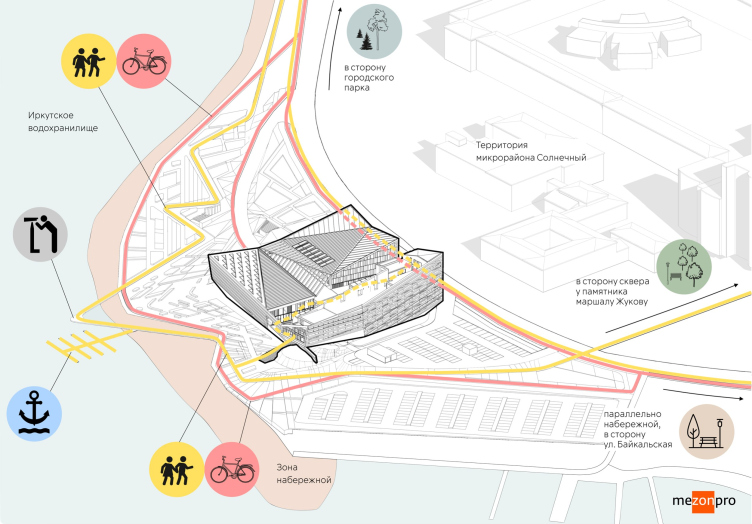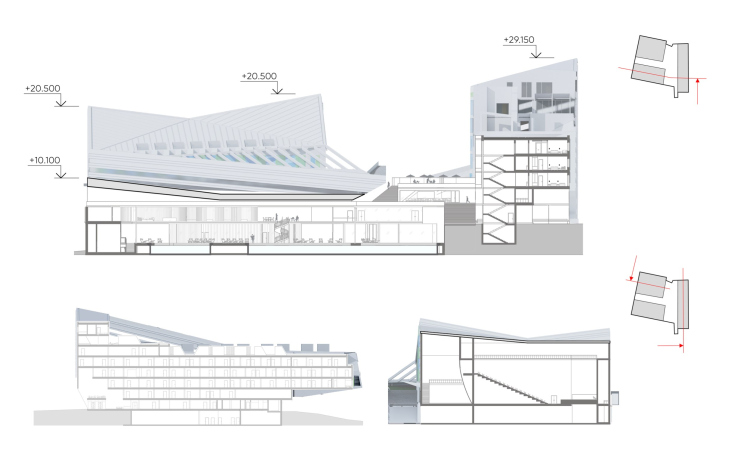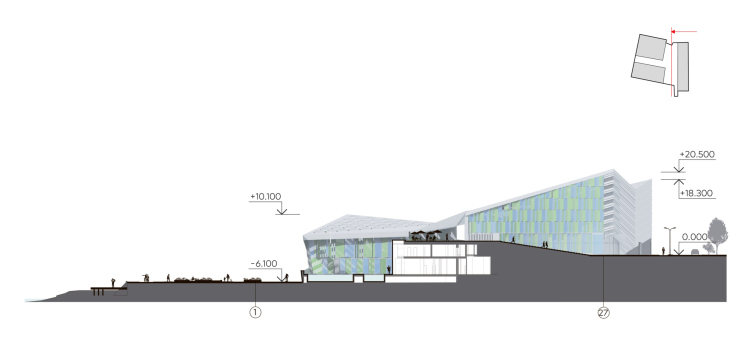The hotel with water-and-wellness center in Irkutsk
Copyright: © Mezonproject
The hotel with water-and-wellness center in Irkutsk
Copyright: © Mezonproject
The hotel with water-and-wellness center in Irkutsk
Copyright: © Mezonproject
At the same time, the very promising territory of the peninsula’s “spit” (about 5 hectares), originally allocated for public function, still lies undeveloped. Only at the beginning of 2023, the Irkutsk branch of the Union of Architects of Russia, commissioned by the local company SIBAR, organized and held an architectural competition for the best project to develop the embankment of the Solnechny micro-district. The winning concept was developed by the Moscow-based company Mezonproject, which combines a broad functional program of the main volume with a bright and yet locally related image, while the spacious territory (the already-mentioned 5 hectares) around the complex receives a well thought-out modern landscaping with various usage scenarios.
The hotel with water-and-wellness center in Irkutsk
Copyright: © Mezonproject
The hotel with water-and-wellness center in Irkutsk
Copyright: © Mezonproject
The hotel with water-and-wellness center in Irkutsk
Copyright: © Mezonproject
Having carefully analyzed the current urban planning situation and the prospects for its further development, the architects carefully fitted the new volume into all the existing axes, ensuring the transparency and multiple connections of the new fragment of the urban fabric. The building obviously had to have an iconic, eye-catching shape, and the famous Baikal ice hummocks with their characteristic layered pattern were used as a visual image. Two more important characteristics are the integrity and sculptural nature of the building, because it should look great from many different vantage points. The invented image was superimposed on a complex functional scheme; the architects carefully analyzed how the new object would be perceived from the water, from the dam, from the residential district, and from the boulevard (a green boulevard perpendicular to Marshal Zhukov Avenue was planned in the district back in the 1970s, but was never built, and now the city authorities are planning to revitalize the idea). The result is a monochrome volume with active dynamics of longitudinal lines on the facades, which is precisely integrated into the urban space and is perfectly perceived in motion. The raised corners marking the entrances play an important role in this. The 7.5 m height difference on the site further enriches the composition and actively contributes to the solution of all of the tasks.
The hotel with water-and-wellness center in Irkutsk
Copyright: © Mezonproject
The hotel with water-and-wellness center in Irkutsk
Copyright: © Mezonproject
The complex that we have designed is actually not as massive as it may seem: its total area will only be 11,225 m2, and its maximum height is just under 30 meters. The main difficulty of the project was its multifunctional character. We had to connect the water and recreation center, the hotel, the multifunctional hall and public spaces in such a way that all these four parts (so different in their purpose) exist not as mechanically connected self-sufficient spaces, but as a single system. In order to achieve this goal, it was still necessary to carefully consider all the internal interconnections, the scheme of using the complex and the subtleties of service.
The functional structure of the complex is easy to read. The main dominant feature is the 120-room hotel building, which has a maximum permitted height of 29.15 meters. Its staggered composition (from 1 to 7 floors) will make it possible to form open-air terraces with impressive views of the lake – the upper part will house upscale rooms. The entrance to the hotel is planned from the side of the future boulevard.
The hotel with water-and-wellness center in Irkutsk
Copyright: © Mezonproject
Smaller volumes accommodate the multipurpose hall and the water complex, which look as though they support the main hall. The transformable hall with a retractable telescopic podium for 736 seats can be accessed from Marshal Zhukov Avenue. If necessary, it can be combined with the foyer of the second floor, which also houses a large meeting room. As a result, a flexible space is created, convenient for a variety of business and entertainment events. The lowest volume accommodates the recreation area with swimming pools, which is logically facing south. The entrance to it is designed from the waterfront, and there will also be year-round heated outdoor pools. On the second level there will be a phytobar, a fitness room and a SPA-complex. All the functional parts will be united by an open public promenade with terraces and a restaurant overlooking it. It is this end-to-end passage that will ensure the necessary transparency of the entire complex and the integrity of the urban fabric.
The hotel with water-and-wellness center in Irkutsk
Copyright: © Mezonproject
For the finishing of the “layered” facades, glass fiber concrete was proposed, the protruding strips of which alternate with ribbons of glazing. This noble-looking monolithic material allows you to achieve almost any shape, and it has not been used in the Irkutsk region yet, so the architects hope to bring new, promising technologies to the project. The basement part will be covered with natural stone, and the bevels of the corner entrances will receive mirror surfaces. In continuation of the ice theme, special glass of bluish and greenish shades will be used for glazing the balconies and part of the internal facades. Finally, the slopes of the zinc roof of the volumes can also be adapted to accommodate photovoltaic panels.
The hotel with water-and-wellness center in Irkutsk
Copyright: © Mezonproject
The hotel with water-and-wellness center in Irkutsk
Copyright: © Mezonproject
The most important part of the project is the development of the territory around the complex. On the side of the yacht club and the marina an open parking lot for 200 cars is designed (a small closed parking lot is also provided under the hotel building). There will also be a long pedestrian route along the waterfront with relief drops and a sightseeing platform over the water, and a looped bicycle route. Their location takes into account the existing spontaneous path network. Beach infrastructure and a special fishing pier will be created directly on the shore.
The hotel complex with an aquatic and health center is the second project done by Mezonproject for Irkutsk. As in the Ushakovka river embankment development concept, we were again trying to work with the site from the point of view of overall urban development and offer not only functional architectural solutions, but also landscaped public areas. When getting to know Irkutsk, we had the impression that it was an excellent, very strong and solid city, with very interesting wooden historical buildings, but it lacked some iconic, attractive places. Given the important, very favorable location of the new facility, which is viewed literally from all sides, we hoped that it would play a positive role and create a new point of attraction. This is further facilitated by the functional program: a hotel, swimming pools, gyms, various entertainment elements and high-quality landscaping right on the bank of the reservoir will be appreciated by both tourists and locals. The result will be a center of active urban life that will help Irkutsk in its aspiration to become not just an interesting, but a truly modern city.
The hotel with water-and-wellness center in Irkutsk
Copyright: © Mezonproject
The hotel with water-and-wellness center in Irkutsk
Copyright: © Mezonproject
The hotel with water-and-wellness center in Irkutsk
Copyright: © Mezonproject
The hotel with water-and-wellness center in Irkutsk
Copyright: © Mezonproject
The hotel with water-and-wellness center in Irkutsk
Copyright: © Mezonproject
The hotel with water-and-wellness center in Irkutsk
Copyright: © Mezonproject

